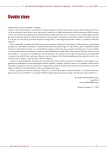Obesity and atherosclerosis – what’s the link?
Authors:
P. Sucharda
Authors‘ workplace:
3. interní klinika 1. lékařské fakulty UK a VFN Praha, přednosta prof. MU Dr. Štěpán Svačina, DrSc., MBA
Published in:
Vnitř Lék 2010; 56(4): 289-291
Category:
11th National Diabetes Symposium "Diabetes and Angiology", Hradec Kralove, 5 to 6 June 2009
Overview
Obesity, primarily abdominal obesity, is a significant risk factor for symptomatic atherosclerosis. Atherosclerotic vascular changes and the pandemic of obesity are connected with the civilization process, in particular with diet modification and shortage of exercise and physical effort. The clinically defined metabolic syndrome is the most prominent atherosclerotic risk factor based on adipose tissue dysfunction producing low grade inflammation and endothelial dysfunction.
Key words:
obesity – abdominal obesity – metabolic syndrome – adipose tissue – atherosclerosis
Sources
1. Cordain L, Eaton SB, Sebastian A et al. Origins and evolution of the Western diet: health implications for the 21st century. Am J Clin Nutr 2005; 81: 341– 354.
2. O’Keefe JH Jr, Cordain L, Harris WH et al. Optimal low‑ density lipoprotein is 50 to 70 mg/ dl: lower is better and physiologically normal. J Am Coll Cardiol 2004; 43: 2142– 2146.
3. Power ML, Schulkin J. The evolution of obesity. Baltimore: Johns Hopkins University Press 2009.
4. Balák L. Moravský gravettien – pavlovien. Available from: http:/ / www.iabrno.cz/ agalerie/ pavlov.htm.
5. Wattendorf DJ, Muenke M. Prader‑ Willi syndrome. Am Fam Physician 2005; 72: 827– 830.
6. Haslam DW, James WPT Obesity. Lancet 2005; 366: 1197– 1209.
7. Kelly T, Yang W, Chen CS et al. Global burden of obesity in 2005 and projections to 2030. Int J Obes 2008; 32: 1431– 1437.
8. Olshansky SJ, Passaro DJ, Hershow RC et al. A potential decline in life expectancy in the United States in the 21st century. N Engl J Med 2005; 352: 1138– 1145.
9. Calle EE, Thun MJ, Petrelli JM et al. Body‑mass index and mortality in a prospective cohort of U.S. adults. N Engl J Med 1999; 341: 1097– 1105.
10. Stevens J, Cai J, Pamuk ER et al. The effect of age on the association between body‑mass index and mortality. N Engl J Med 1998; 338: 1– 7.
11. Chen Z, Yang G, Zhou M et al. Body mass index and mortality from ischaemic heart disease in a lean population: 10 year prospective study of 220,000 adult men. Int J Epidemiol 2006; 35: 141– 150.
12. Zhou M, Offer A, Yang G et al. Body mass index, blood pressure, and mortality from stroke: a nationally representative prospective study of 212,000 Chinese men. Stroke 2008; 39: 753– 759.
13. Vague J. The degree of masculine differentiation of obesities: a factor determining predisposition to diabetes, atherosclerosis, gout, and uric calculous disease. Am J Clin Nutr 1956; 4: 20– 34.
14. Krotkiewski M, Björntorp P, Sjöström L et al. Impact of obesity on metabolism in men and women. Importance of regional adipose tissue distribution. J Clin Invest 1983; 72: 1150– 1162.
15. Reaven GM. Banting Lecture 1988. Role of insulin resistance in human disease. Diabetes 1988; 37: 1595– 1607.
16. Alberti KGMM, Zimmet P, Shaw J. Metabolic syndrome – a new world‑ wide definition. A Consensus Statement from the International Diabetes Federation. Diabet Med 2006; 23: 469– 480.
17. Reaven GM. Insulin resistance, cardiovascular disease, and the metabolic syndrome. How well do the emperor’s clothes fit? Diabetes Care 2004; 27: 1011– 1012.
18. Mikhail N. The metabolic syndrome: insulin resistance. Curr Hypertens Rep 2009; 11: 156– 158.
19. Lau DC, Dhillon B, Yan H et al. Adipokines: molecular links between obesity and atherosclerosis. Am J Physiol Heart Circ Physiol 2005; 288: H2031– H2041.
20. Egger G, Dixon J. Obesity and chronic disease: always offender or often just accomplice? Br J Nutr 2009; 102: 1238– 1242.
21. Anděl M, Polák J, Kraml P et al. Chronický mírný zánět spojuje obezitu, metabolický syndrom, aterosklerózu a diabetes. Vnitř Lék 2009; 55: 659– 665.
22. Fabbrini E, Magkos F, Mohammed BS et al. Intrahepatic fat, not visceral fat, is linked with metabolic complications of obesity. Proc Natl Acad Sci 2009; 106: 15430– 15435.
23. Arslan U, Türkoğlu S, Balcioğlu S et al. Association between nonalcoholic fatty liver disease and coronary artery disease. Coron Artery Dis 2007; 18: 433– 436.
24. Sakurai M, Takamura T, Miura K et al. Abnormal liver function tests and metabolic syndrome – is fatty liver related to risks for atherosclerosis beyond obesity? Intern Med 2009; 48: 1573– 1574.
25. Hajer GR, van Haeften TW, Visseren FL. Adipose tissue dysfunction in obesity, diabetes, and vascular diseases. Eur Heart J 2008; 29: 2959– 2971.
26. Sucharda P. Abdominální obezita. Čas Lék Čes 2009; 148: 78– 82.
27. Björntorp P. Do stress reactions cause abdominal obesity and comorbidities? Obes Rev 2001; 2: 73– 86.
28. Shively CA, Register TC, Clarkson TB. Social stress, visceral obesity, and coronary artery atherosclerosis: product of a primate adaptation. Am J Primatol 2009; 71: 742– 751.
29. Saad F, Gooren L. The role of testosterone in the metabolic syndrome: a review. J Steroid Biochem Mol Biol 2009; 114: 40– 43.
30. Després JP, Lemieux I, Bergeron J et al. Abdominal obesity and the metabolic syndrome: contribution to global cardiometabolic risk. Arterioscler Thromb Vasc Biol 2008; 28: 1039– 1049.
Labels
Diabetology Endocrinology Internal medicineArticle was published in
Internal Medicine

2010 Issue 4
Most read in this issue
- Angiopathy and the eye
- Peripheral arterial disease and diabetes
- Surgical treatment of ischemic heart disease and diabetes mellitus
- Diabetes mellitus and ischemic heart disease
